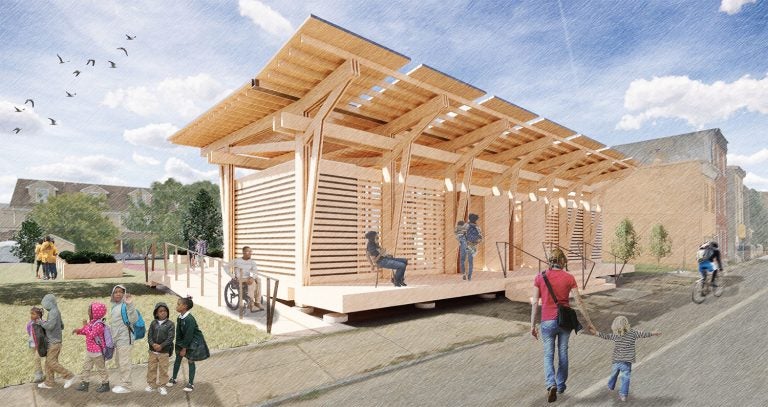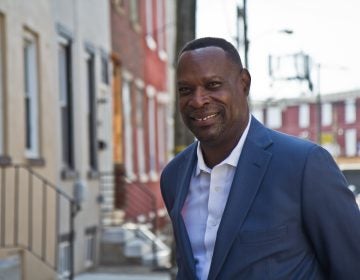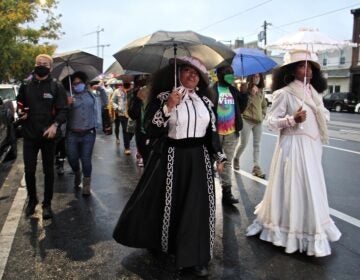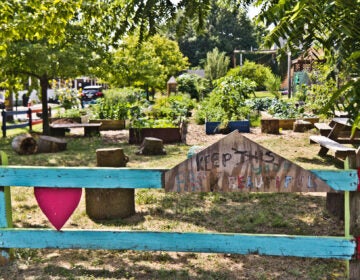Why North Philly Peace Park is building an Afrofuturist pavilion
North Philly Peace Park educator Kermit O on the Sala Keturah STEM Pavilion and its meaning as a space of self-determination and a continuation of the Black struggle.

An artist's rendering of the Sala Keturah STEM Pavilion designed by Nyasha Felder and under construction at North Philly Peace Park. (Courtesy of North Philly Peace Park)
Last Saturday, I joined North Philly Peace Park staff, volunteers, and Sharswood community members — generations of Black people, from infants to elders — for the groundbreaking of the Sala Keturah STEM Pavilion.
The project — a stunning fusion of Afrofuturist aesthetic and sustainable design — will serve as the centerpiece of an ecocampus that will span a full block of the Sharswood neighborhood. The pavilion is part of a larger project to model Black self-determination through agriculture, design, education, wellness, and cooperative economics.
Maya Thomas, lead planner in the building of the pavilion, sees the Peace Park as a case study, providing a pathway for Black communities to push back against gentrification. She says that where people feel helpless in the face of relentless redevelopment, the Peace Park offers a “competing ideal,” an alternative that genuinely meets the needs of the community.
From the electric enthusiasm of the young people as they drilled their shovels into the earth, to Maya Thomas’s tears of joy, it was clear that the event also represented the breaking of a tide, the crossing of a threshold from dreams to realization. The event was filled with joy and camaraderie, the Park vibrating with the creative energy and the will to see the dream fulfilled.

If you aren’t familiar with the Peace Park, the gist is this: Community members in the Sharswood neighborhood of North Philadelphia came together to clean up and restore health to a parcel of land, and convert it to a sustainable space for growing food and building community. They did not ask for “permission” from the owners — the Philadelphia Housing Authority — because no one should need permission to thrive. This early work set in motion a nine-year struggle between the Park and PHA, for the very right to self-determination. It is a struggle that has always been rooted in control of the land, from Indigenous dispossession, through the displacement of Black farmers in the South, into the present where many battles are being waged over the question of land sovereignty. As explained by mixed-media artist and scholar Li Sumpter, a member of the Peace Park design and education teams, “this idea of reclaiming space and reclaiming land, of ownership and agency, has always been a part of the Peace Park strategy of community building.”
Community elder Mama Gail guided the attendees in calling Black ancestors into the space, while also inviting us to dream the future into being. In the words of lead architect Nyasha Felder, the pavilion will “function as a time capsule, by retaining the cultural significance of place-making through the lens of Black radical space.”
Collective dreaming and the Black struggle
The theme of the groundbreaking ceremony was tracing the continuity of Black struggle, resistance, and resilience. Fifty years ago, community activist, educator, and scholar John Elliott Churchville started the Freedom School on Ridge Avenue, a mere three blocks from North Philly Peace Park. His mission, from 1964 to 1978, was Black self-determination, which he recognized as incompatible with education provided by the State. Churchville honed his vision through the lens of revolutionary nationalism, an ideological current that finds one of its most coherent manifestations today in North Philly Peace Park. Philly school teacher and Peace Park education team member Nzinga Hill wants to cultivate “intellectually sound, spiritually grounded, culturally knowledgeable liberators.” Young people, Hill believes, need to be “uncompromising,” steeped in Black thought, Black struggle, and Black scholarship. The Civil Rights and Black Power movements are always discussed in the past tense, but they should rather be understood as part of a continuum. Emblematic of that political lineage, Dr. John Churchville himself was among the guests for the groundbreaking of the Sala Keturah Pavilion.
Philly is a “city of neighborhoods,” really a city of blocks, such that we often aren’t aware of the greatness taking place right under our noses. There have been a few times out at the Park when local residents have approached me to ask what it’s all about. It’s striking to me that even people who live within walking distance are unaware of this vital space where they are free to harvest food directly from the land, or from the numerous food giveaways. This resourceful space where Black people were creating natural balms and tinctures, art, crafts, and other products, during monthly Green Wall Street gatherings. This magical space, where Black people were coming together for conversations about strategies, logistics, and the very contours of self-determination. This space which has become a convergence point for the ingenuity and creativity of so many people, from educators and activists to artists and architects, to beautiful Black children seeking a place to be their essential selves, wild and free.
Also. Y’all. Did I mention that there are beehives and a solar smart cube?
All the things that North Philly Peace Park is, and will become, are part of a continuum of collective dreaming, striving, and will toward self-determination: the heart of all Black struggle. The life of Black people in this country has always been defined by the tension between our demand for sovereignty, and the violent refusal by the state at every juncture to entertain the mere idea. From the murder of Octavius Catto, situated at the center of a relentless campaign of anti-Black violence against our attempts to vote, to the institutionalized violence of the police, carceral system and the courts, any whiff of Black mobility or agency is met with full-throttled resistance by the State and its proxies.
Reemerging into the public consciousness, due to revelations of the egregious violence toward Black people even after death, is the history of the MOVE organization, and the military-style campaign launched against them on May 13, 1985. It is a story of grotesque violence, profane cruelty, and an utter contempt for Black life. Pertinent here, is what the MOVE organization was before this redefining incident, and what they have continued to be in the aftermath: a collective of Black people who chose to divest from a white supremacist, patriarchal, ecologically devastating, capitalist system. Black people who chose to educate and care for their own children, rather than remanding them to state control. Black people who chose to eat and sustain themselves through their own labor, rather than the mediated exchange of the money economy. Black people who embodied self-determination.
And how did the State respond? With a bomb, and ten thousand bullets. Because the viability of our political and economic system depends on Black subordination.
North Philly Peace Park occupies the same continuum as MOVE in the ongoing struggle for Black self-determination. The Park was also the victim of state violence, when the police raided the buildings they were renovating, under the false pretext of drug activity. While what happened at the Park was incommensurate in scale, historical impact, and the deep, reverberating trauma experienced by MOVE, it was a reminder of how any attempts by Black people to be self-determined will be met with fierce resistance by the State.
It was the strength and support of the Sharswood community which saw the Peace Park emerge on the other side, in an even better position. The Park has since been given control over the land and buildings at the site, and the necessary permissions to move ahead with the construction of the pavilion — itself a representation of continuity, being inspired by the Oshun temples of Nigeria and the shotgun houses of the Black South.
Felder says that even though there is much to learn from the past, “when it comes to responding to our current needs, we have to innovate, we have to create something for the now, and for the future.” The pavilion, Li Sumpter says, will create a space for Black people “to design, to dream, as we see fit for our futures.”
North Philly Peace Park represents a radical vision for Black self-determination, one that we hope can be replicated throughout the city. In line with the very meaning of the word “radical,” our work starts at the roots — both literal and historical — tracing the continuity of Black struggle and Black resilience, to branch out toward countless possibilities for peaceful, thriving, self-determined Black futures.
Kermit O is a former teacher turned school abolitionist, working as a community educator and organizer at the intersection of land, food, and climate justice. He serves on the city’s Food Policy Advisory Council, interns with the Philadelphia Orchard Project, and is part of a team developing educational programming at North Philly Peace Park. This article was adapted from a longer version, which can be found on Kermit’s personal blog.

Subscribe to PlanPhilly
WHYY is your source for fact-based, in-depth journalism and information. As a nonprofit organization, we rely on financial support from readers like you. Please give today.








